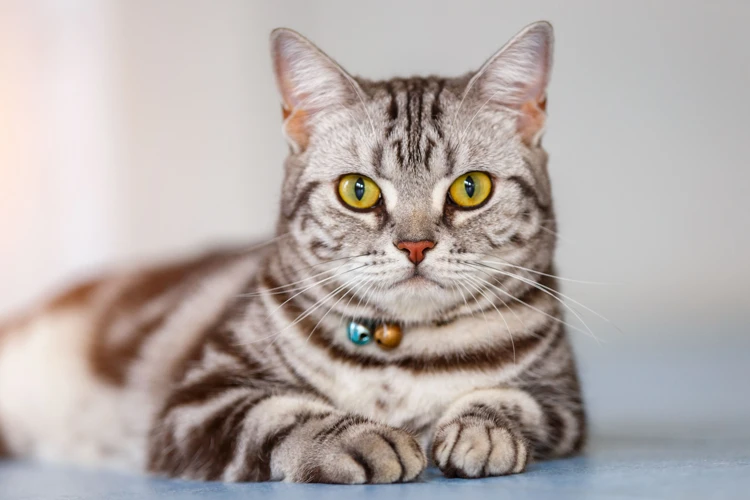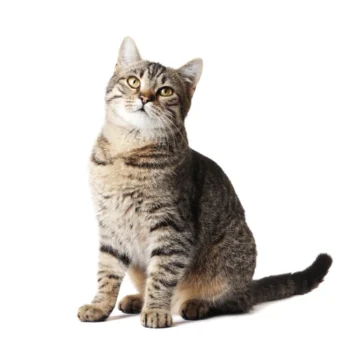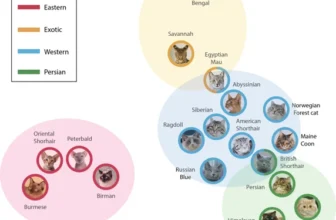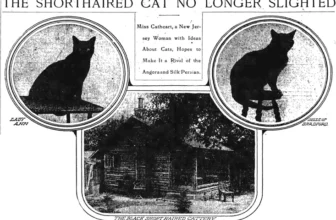Have you ever wondered about the origins and history of the American Shorthair breed? These beloved cats have been a fixture of North American households for centuries, but their story stretches back even further. From early crossbreeding to changes in breed standards, the evolution of the American Shorthair has been a fascinating process. In this article, we’ll explore the unique history and characteristics of this breed, highlighting their physical features, personality traits, and more. Get ready to discover the fascinating world of the American Shorthair!
The Origins of American Shorthair Breed

The history of the American Shorthair breed is a fascinating journey that spans centuries of evolution. With fascinating influences from both domestic and European shorthair cats, the American Shorthair breed has a rich and unique genetic ancestry that has contributed to its distinct physical features and personality traits. In this section, we will explore the origins of the American Shorthair breed, starting with its early history, the foundation of the breed, and the crossbreeding that helped shape its genetic diversity. We will also delve into the influence of European shorthair cats on the American Shorthair breed, as well as the impact of domestication on its evolution. For more information on the genetic ancestry of American Shorthair cats, you can refer to our article on genetic ancestry of American Shorthair cats.
Early History
During the Early History of American Shorthair Breed, these cats were originally brought to North America by European settlers to control rodents on their boats. These cats were bred with working cats in the colonies, leading to the development of a sturdy cat that could withstand harsh American conditions. As a result, American Shorthair cats were popular among farmers and households as they were effective in controlling pests.
Euro-American Influence: With the arrival of European settlers in North America came several breeds of cats, including the English Shorthair and the Persian. These breeds played a significant role in the development of the American Shorthair. The crossbreeding of these cats with the working cats in the colonies helped in establishing a breed that was well suited for survival in the New World.
Domestication and Genetic Diversity: Genetic diversity was essential in the evolution of American Shorthair Breed. This breed is known for its robust health and longevity, which is partly due to their diverse genetic makeup. The domestication of American Shorthair cats played a significant role in their evolution, as they were bred and developed to adapt to the changing needs of their human companions.
Influence of Cat Shows: In the early 1900s, cat shows became very popular in America. This helped in the promotion and breeding of American Shorthair cats. Several cat associations recognized their distinct characteristics, and American Shorthair cats became a staple in cat shows across the country. The breeders started working on improving and refining their characteristics, leading to the establishment of a set of standards that define the breed’s characteristics.
To know more about the Evolution of American Shorthair Breed, check out this article.
Setting Foundation
Setting Foundation
The foundation of the American Shorthair breed can be traced back to the early American settlers who brought their cats with them on ships. These cats were vital to the survival of the settlers as they helped control the rodent population, which was a constant threat to food supply. The original cats were likely domesticated European shorthair cats and provided the foundation for the American Shorthair breed.
Over time, these cats evolved to adapt to the North American climate and lifestyle. They were bred for their hunting abilities and their sturdy, muscular build. The breed began to become more standardized in the late 19th century when cat fanciers began to take an interest in breeding cats for show.
Along with the influence of domesticated European shorthair cats, other breeds such as the Siamese and Persian cat breeds were also introduced and had an impact on the American Shorthair breed’s evolution. The Siamese cats, for instance, introduced the silver tabby color that is now a hallmark of the American Shorthair breed.
Interestingly, the American Shorthair breed almost became extinct during World War II due to lack of breeding efforts. Efforts to save the breed were made, and they were ultimately successful, leading to the continued existence and evolution of the breed.
The American Shorthair breed’s foundation was set by domesticated European shorthair cats brought to North America by early settlers. Over time, the breed evolved to adapt to the North American climate and lifestyle, and further evolution was influenced by the introduction of other breeds. The breed was almost extinct but was saved by dedicated breeding efforts.
For more information on the influence of domesticated European shorthair cats on the American Shorthair breed, visit eu-shorthair-cats-influence-on-am-shorthair-cats.
Crossbreeding
Crossbreeding played a significant role in the evolution of American Shorthair breed. During the early years, these cats were crossbred with various other breeds like British Shorthairs, Siamese, and Persians. Through this process, American Shorthairs gained desirable traits such as strong bone structure, rounder eyes, and a denser coat. Crossbreeding with Siamese cats added the genetic factor for silver coat color to American Shorthairs, which is one of the more popular colors today.
The genetic diversity obtained through crossbreeding allowed for a healthier and stronger breed to emerge. By adding new genes to the breed, undesirable traits were eliminated through natural selection. For example, the Siamese crossbreeding eliminated the tendency for American Shorthairs to develop obesity problems.
Interestingly, even today, American Shorthairs are sometimes crossbred to introduce new coat colors, patterns, and traits. However, breeders are careful to maintain the distinct physical features and temperaments that make American Shorthairs a beloved breed amongst cat lovers.
If you want to learn more about the evolution of American Shorthair breed, or the impact of domestication of cats on their evolution, please click on the links.
Evolution of American Shorthair Breed in North America

When it comes to the evolution of the American Shorthair breed in North America, there is a rich history to explore. From changes in breeding standards to rising popularity, the journey of this breed has been an interesting one. Let’s take a closer look at how this beloved cat breed has evolved over the years. For more information on the history and traits of the American Shorthair breed, check out this article on American Shorthair Cat Breed Traits and History. Additionally, for a deeper dive into the genetic diversity of American Shorthair cats, take a look at this article on Genetic Diversity in American Shorthair Cats.
Changes in Standards
Over the years, the standards for the American Shorthair breed have undergone notable changes. The breed standard is a written description of the ideal physical and temperamental characteristics of a breed, which is used to judge cats in cat shows.
Changes in Body Conformation
Early American Shorthairs were medium in size with a strong, athletic build. However, as the breed became more popular in the show circuit, breeders began selectively breeding for certain traits, leading to a change in the breed’s body conformation. Today, American Shorthairs have a sturdy, muscular build with a short, thick tail. Their head is round and broad with high cheekbones, and their ears are medium to large in size, slightly rounded at the tips and set far apart on their head.
Changes in Coat Colors and Patterns
Originally, the American Shorthair breed was limited to a single color, silver tabby. However, over time, breeders introduced new coat colors and patterns such as black, white, calico, and tortoiseshell. Today, the breed standard permits a range of colors and patterns, so long as the coat is dense, short, and plush, with a bright and lustrous appearance.
Changes in Temperament Standards
The temperament of the American Shorthair has always been one of its most attractive qualities. These cats are known for being friendly, affectionate, and adaptable. However, over the years, the breed standards have placed greater emphasis on the importance of a calm and easygoing demeanor. Today, American Shorthairs are expected to be patient, tolerant, and affectionate, making them an ideal choice for families with children or other pets.
The changes in the American Shorthair breed standards have helped to shape the breed into what it is today. While these changes have been gradual, they have allowed breeders to refine the breed’s physical and temperamental characteristics, resulting in a loyal and loving companion that is adored by cat lovers across the world.
| Changes in Standards | Description |
|---|---|
| Body Conformation | Medium sized to sturdy, muscular builds with a round broad head, high cheekbones, medium to large-sized ears and a short, thick tail. |
| Coat Colors and Patterns | Originally limited to silver tabby color, now allows a range of colors and patterns including black, white, calico, and tortoiseshell. |
| Temperament Standards | Greater emphasis on a calm and easy-going demeanor, while maintaining their friendly, affectionate, and adaptable nature. |
Popularity in America
In the mid-20th century, the American Shorthair breed rose to popularity in America, becoming one of the most sought-after cat breeds in the country. This was in part due to its appearance in movies and television shows, such as the famous orange tabby cat named “Morris” in 9Lives cat food commercials in the 1970s.
Factors that contributed to the breed’s popularity include:
- The breed’s loyalty and affectionate personality towards their owners, making them excellent companions for families and individuals.
- Their low-maintenance grooming needs, with their short, dense coat only requiring weekly brushing to maintain its shine.
- Their adaptability to both city and suburban lifestyles, making them popular choices for apartment dwellers and those with larger homes.
- Their reputation as healthy and long-lasting pets, with an average lifespan of 15-20 years
Besides being a popular household pet, the American Shorthair breed also became a valuable asset to farmers and households as mousers, helping to control rodent populations. Their skills in hunting and catching rodents was put to good use during World War II when they were used on ships to prevent rodent infestations.
The American Shorthair breed’s popularity in America can be attributed to its many positive traits, making them excellent companions for people looking for a loving and low-maintenance pet that can adapt to different lifestyles.
Role of Cat Shows
The role of cat shows has been crucial to the evolution and popularity of the American Shorthair breed. These shows have served as a platform for breeders to showcase their cats and have contributed to the development of breed standards.
1. Establishing Standards: At cat shows, breeders are judged according to specific standards created by cat associations such as The International Cat Association (TICA) and the Cat Fanciers’ Association (CFA). These standards outline the ideal physical characteristics and personality traits that a breed should possess. The American Shorthair breed standard was established in the 1960s and has since been refined through the feedback received at successive cat shows.
2. Encouraging Selective Breeding: American Shorthair breeders use cat shows as an opportunity to selectively breed cats that meet breed standards. Only the cats that meet the standard win awards and move on to become part of a breeding program. This selective breeding has helped to improve the health and personality traits of the breed.
3. Enhancing Popularity: Cat shows also provide a platform to introduce cat lovers to the American Shorthair breed. The awards won at cat shows go a long way in boosting the popularity of the breed. Over time, this has helped to increase demand for the breed, which in turn promotes its continued breeding and evolution.
4. Networking: Cat shows also give breeders the opportunity to network with other breeders and cat enthusiasts. This can lead to the sharing of knowledge, ideas and the potential for collaborations. This exchange of ideas is vital to the continued growth and evolution of the breed.
5. Recognition: The continued showcasing of the American Shorthair breed at cat shows has also led to recognition by other cat associations such as The International Cat Association (TICA) and the Cat Fanciers’ Association (CFA). These recognitions have given the breed a seal of approval and added to its popularity.
Cat shows have played an important role in the evolution and promotion of American Shorthair breed. Cat shows have encouraged selective breeding, established breed standards, enhanced popularity, provided networking opportunities and led to recognition by other cat associations. Breeders and cat enthusiasts look forward to the continued showcasing of this amazing breed at cat shows.
Recognition by Cat Associations
Recognition by Cat Associations is an important consideration when it comes to the American Shorthair breed. These associations have played a major role in promoting and protecting the breed. Through the years, the American Shorthair breed has gained recognition from several cat associations in North America.
The Cat Fanciers Association (CFA) recognized the American Shorthair breed in 1906 as the Shorthair. In 1966, the breed’s name was officially changed to American Shorthair. The CFA is one of the largest cat organizations in the world and is known for its rigorous breed standards. In order for a cat to be recognized by the CFA, it must meet these standards.
The International Cat Association (TICA) recognized the American Shorthair breed in 1979. It is the largest genetic registry of cats in the world. The TICA offers cat shows, cat breed standards, and other resources for cat lovers.
The American Cat Fanciers Association (ACFA) is a smaller organization that recognized the American Shorthair in 1962. The ACFA is known for its friendly atmosphere and providing a welcoming experience for both cats and cat owners at their shows.
Below is a table summarizing the recognition of the American Shorthair breed by cat associations in North America:
| Cat Association | Year of Recognition |
|---|---|
| Cat Fanciers Association (CFA) | 1906 |
| International Cat Association (TICA) | 1979 |
| American Cat Fanciers Association (ACFA) | 1962 |
Having recognition by these organizations is important for breeders and cat owners who want to participate in cat shows, breeding programs, and other activities related to cats. The recognition by these associations also gives credibility to the breed and ensures the preservation of its standards and characteristics.
Appearance and Characteristics of American Shorthair Breed
As we delve into what makes American Shorthair cats unique, it’s impossible not to analyze their remarkable appearance and diverse characteristics. From physical features to personality traits, the American Shorthair breed entices cat lovers across the world. By highlighting their most stunning physical features, wide range of coat colors and patterns, and lovable personality traits, we can gain a deeper appreciation for this breed’s special charm. Let’s explore what makes American Shorthair cats stand out from the crowd!
Physical Features
The American Shorthair cat is a medium-sized feline known for its muscular build and well-balanced appearance. Here are some distinct physical features that make this breed stand out:
- Head: The American Shorthair has a broad, rounded head with full cheeks and a well-defined muzzle. Their large, wide-set eyes are usually bright and expressive.
- Ears: Their ears are medium in size and set slightly apart, with a rounded tip.
- Body: The American Shorthair boasts a sturdy, athletic body with a strong spine and muscular legs. The males are generally larger than females and can weigh up to 15-20 pounds.
- Tail: Their tails are thick and medium in length, tapered towards the tip.
- Fur: As the name suggests, the American Shorthair has a short, dense, and glossy coat that lies close to their body.
- Color: While the breed comes in a variety of colors, the classic silver tabby pattern is the most popular among cat enthusiasts.
In addition to their physical features, the American Shorthairs have an adorable round face with a sweet expression. They also have a strong and powerful build, which adds to their overall appearance of athleticism and agility. These traits, along with their gentle and affectionate personalities, make them a popular choice for families and cat lovers alike.
Coat Colors and Patterns
American Shorthair cats are known for their distinct and captivating coat colors and patterns. These felines come in a wide range of colors and patterns, making them a popular choice among cat enthusiasts. Let’s have a closer look at some of the most common coat colors and patterns of American Shorthair cats.
Coat Colors:
| Color | Description |
| ——————— | ——————————————————————————- |
| Silver | A bright and shiny coat with black markings on the tips of hair |
| Smoke | A black or blue color at the base of fur with white, silver, or golden tips |
| Black | Solid black color |
| White | A pure white coat with no markings or patterns |
| Cream | An off-white or pale creamy color |
| Blue | A grayish-blue color |
| Red | A reddish-brown color |
| Cameo | A mixture of red and cream |
| Tortoiseshell | A mix of black and red or cream fur with distinct splotchy patterns |
| Calico | A mix of white, black and red or cream fur with distinct splotchy patterns |
Coat Patterns:
| Pattern | Description |
| ——————— | ——————————————————————————- |
| Classic or blotched | A swirly or marble-like pattern that is common among American Shorthairs |
| Mackerel | Vertical lines or stripes along the spine |
| Tabby | A combination of both classic and mackerel pattern |
| Ticked | A pattern in which individual hair has multiple bands of color |
| Spotted | Circular or oval-shaped spots on the coat |
In addition to these commonly known coat colors and patterns, American Shorthair cats can also be found in other unique coat variations, such as silver patched, blue patched, and bi-color, to name a few.
It is important to note that coat color and pattern do not define the personality or behavior of an American Shorthair cat. No matter their coat type, these felines are known for their playful, affectionate, and loyal nature.
Personality Traits
The American Shorthair is known for being one of the most adaptable and well-behaved cat breeds in North America. They are gentle, playful, and outgoing, making them a great addition to any family. Here are some of the unique personality traits that make them stand out from other breeds:
| Personality Trait | Description |
|---|---|
| Intelligence | The American Shorthair is a highly intelligent breed. They are quick learners and are known for their ability to solve problems. |
| Playfulness | They love to play and are always up for a game. They are great with children and make excellent playmates. |
| Affectionate | They are affectionate cats that enjoy spending time with their owners. They often seek out attention and love to be petted and cuddled. |
| Independent | The American Shorthair has a strong independent streak. They are happy to entertain themselves and do not require constant attention. |
| Athleticism | They are an athletic breed that enjoys running and jumping. They are excellent climbers and can often be found perched up high in their favorite spots. |
| Adaptability | They are adaptable cats that can thrive in a variety of environments. Whether you live in a small apartment or a large house, the American Shorthair will be happy as long as they have plenty of toys and attention. |
The American Shorthair is a wonderful breed that is easy to care for and a joy to be around. With their friendly personalities and easy-going nature, they make excellent pets for families and individuals alike. So, if you’re looking for a feline companion that will bring love and joy into your life, the American Shorthair is definitely worth considering.
Conclusion
After exploring the history and evolution of the American Shorthair breed, it is clear that this feline has a rich and intriguing background. From its beginnings as a skilled mouser on ships to its role as a beloved household pet, the American Shorthair has undergone significant changes over time.
Through crossbreeding and the establishment of standards by cat associations, the American Shorthair developed into the sturdy and affectionate cat we know today. Its loyal and friendly personality, combined with its attractive appearance and low-maintenance coat, have made it a popular choice among cat owners in North America.
However, despite its popularity, it is important to remember that each individual American Shorthair has its own unique personality and characteristics. While some may be more aloof or independent, others may crave attention and affection.
Whether you are a long-time fan of the American Shorthair or are considering adding one to your family, this breed’s history and traits offer a glimpse into its fascinating past and promising future as a beloved companion animal. So if you’re looking for a feline friend that is both charming and low-maintenance, the American Shorthair may be the perfect fit for you and your lifestyle.
Frequently Asked Questions
What is the difference between American Shorthair and domestic shorthair cats?
American Shorthair cats are a specific breed recognized by cat associations, while domestic shorthair cats refer to any shorthaired cat that does not fit a specific breed standard.
How long do American Shorthair cats typically live?
American Shorthair cats have an average lifespan of 15-20 years with proper care.
Are American Shorthair cats good with children?
Yes, American Shorthair cats are known for being friendly and adaptable, and can make great companions for children.
Do American Shorthair cats shed a lot?
While American Shorthair cats do shed, they are considered a low-maintenance breed compared to some other breeds with longer or thicker coats.
What kind of health issues are common in American Shorthair cats?
Like all cats, American Shorthair cats can be susceptible to health issues such as dental disease, obesity, and kidney disease. However, they are generally a robust and healthy breed with few genetic health problems.
What is the personality of an American Shorthair cat like?
American Shorthair cats are known for being friendly, adaptable, and easygoing. They can be playful but also enjoy just hanging out with their owners.
Can American Shorthair cats be trained?
Yes, American Shorthair cats can be trained using positive reinforcement techniques and repetition.
How much exercise do American Shorthair cats need?
American Shorthair cats are moderate in their exercise needs and can be satisfied with playing indoors and some interactive toys.
What kind of diet is best for American Shorthair cats?
American Shorthair cats require a balanced diet of protein, fat, and carbohydrates. It’s important to feed them a high-quality cat food and to monitor their portion sizes to avoid obesity.
Do American Shorthair cats enjoy being lap cats?
Many American Shorthair cats enjoy lounging on their owner’s lap, but each cat is unique and may have their own preferences for how they like to spend time with their owners.







